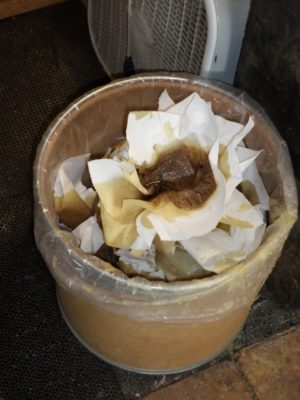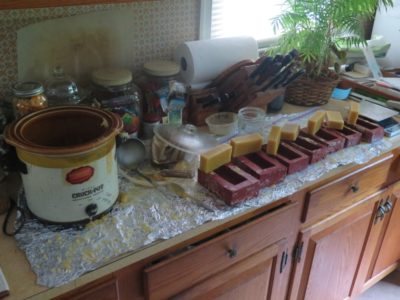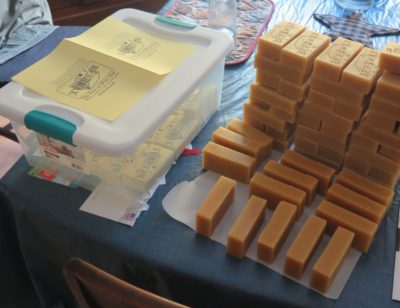Aiming for Amana – Waxing Insights
Mrs. Barn and I are diligently purifying and packaging wax for our upcoming trip to Amana. I thought I might present a refresher post about how we go from bottom-of-the-bucket beeswax from a honey factory to the spectacular golden blocks all wrapped up nicely.

The starting point is this completely unprocessed material from the honey factory, known as “slum gum” in the jargon of the trade. It has wonderful beeswax along with the bee bodies, dirt, and other contaminants from the factory honey-extraction process. My goal for the end product depends on beginning with superb and unmodified raw materials; I do not want to modify the wax with solvents or other chemicals like bleaches. We rely solely on gentle heating to melt the wax multiple filtrations to make it glorious. What you see is what you get.
The first step is to break up the big hunks to melt them in my biggest Crock Pot so that I have roughly half water/half raw, dirty beeswax. By melting the wax in a water bath I can get any water-soluble components out, and it makes the first filtering much easier as I ladle out the steaming solution through a pasta strainer into a cake pan to cool.

As you can see, I get a lot of bee parts in the strainer in the first filtering.



No real effort is made to filter out any dirt at this point, the molten wax/water mixture allows the grit to fall to the bottom of the pan/block and it is embedded there when the block is cooled. I scraped this layer off with a hunting knife which removes more than 95% of the particulate contaminants.


After the block has fully hardened, I can break it up and melt the pieces in the deep fryer, set at about 160*F.



Once that is melted, I filter it through paper towels inside another pasta strainer (I use a lot of paper towels and pasta strainers in this process.) This results in a clear, golden waxy nectar in a cookie pan.

One ancillary benefit to my process is the large inventory of wax-infused paper towels that serve as my daily firestarter in the winter.



After cooling overnight, I pop out the sheet of beautiful beeswax and deliver it to Mrs. Barn in the kitchen. She melts and filters the wax one more time before casting the blocks, which are then wrapped and ready for you.


Join the Conversation!